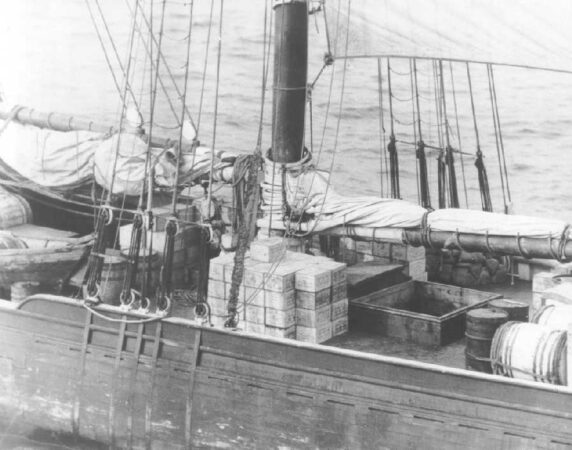On April 21, 1924, the United States Congress extended the territorial limit of U.S. jurisdiction in international waters from three miles to 12. The move was designed to enhance law enforcement efforts during Prohibition, especially in and around Monmouth County, where smuggling was commonplace, and interdiction often futile.
During Prohibition, smugglers sailed the waters between Canada and the Caribbean to bring illegal contraband to the U.S. Monmouth County was a popular place for bringing illegal liquor ashore, with its many small inlets and streams, and a sizeable population of experienced seamen, fishermen and boat-builders, many of whom were involved in bootlegging during this time. The image here shows a bootlegger boat with contraband piled high on the deck.
The legendary Prohibition smuggler Captain William McCoy was credited with the idea of bringing illegal alcohol in large boats just to the edge of the three-mile limit of U.S. jurisdiction, and selling his wares there to “contact boats,” typically local fishermen and small-boat captains. The three-mile limit became known as the “Rum Line,” with the smuggler’s ships drifting just beyond it called “Rum Row.”
While this happened all along the Atlantic coast, the biggest Rum Row was believed to between New York and Philadelphia, off the New Jersey coast, where as many as 60 ships were sometimes seen at one time.
McCoy purchased his wares legally, and sold them in international waters, and so asserted that he was not committing a crime, despite the fact that he was knowingly abetting violations of the Volstead Act, the law that established Prohibition. The Coast Guard would eventually catch up with Bill McCoy and end his bootlegging days forever.
Before the extension of the Rum Line, New Jersey rum-runners could be seen at night racing into remote areas in Raritan Bay in their flat-bottom skiffs, running up on the beach, making a delivery to a waiting truck, and speeding away. These bootleggers typically used a modified Sea Bright skiff or a Jersey skiff, small craft converted into speedboats, often souped-up for maximum speed, able to be launched into heavy surf and safely return to shore, outrunning Coast Guard cutters.
After the Rum Line was extended to 12 miles, it became much harder for these smaller and less seaworthy craft to make the trip. Coast Guard cutters could intercept boats rather than have to chase them down, and as a result, enforcement of Prohibition became much more effective.
Sources:
Burns, Eric (2004). The Spirits of America: A Social History of Alcohol. Philadelphia, PA: Temple University Press. p. 215
Sea Bright Skiff. Navesink Maritime Heritage Association. Available: http://www.navesinkmaritime.org/page-1221444
Image of rum-runner schooner Kirk and Sweeney with contraband stacked on deck. Coast guard Photo No. G-APA-01-13-24 (02) G.F. January 13, 1924, Public Domain.


Leave a Reply